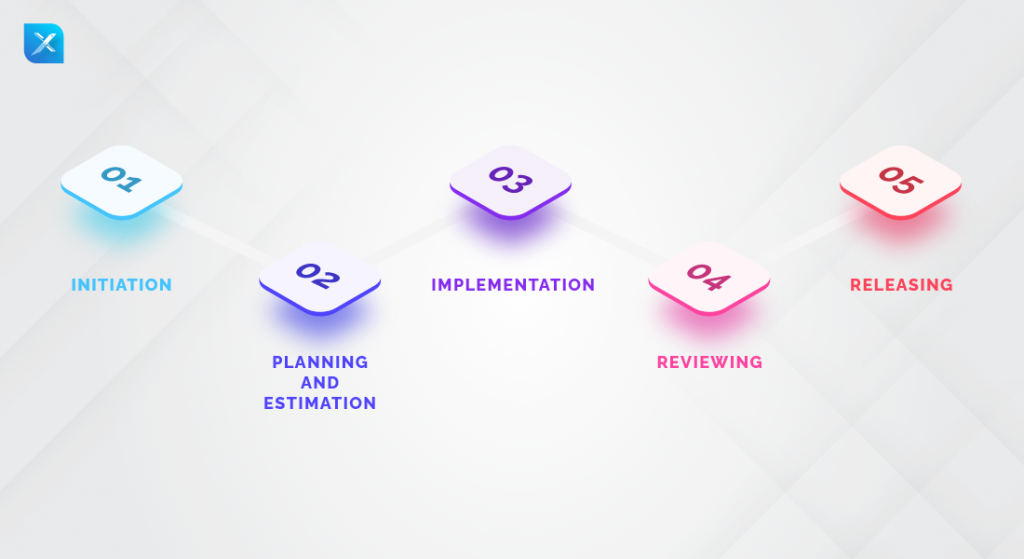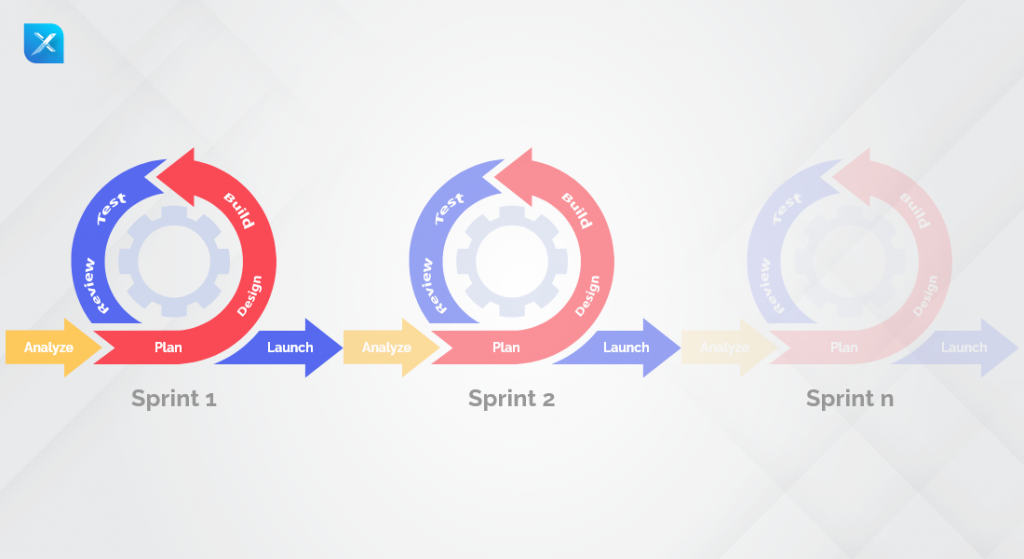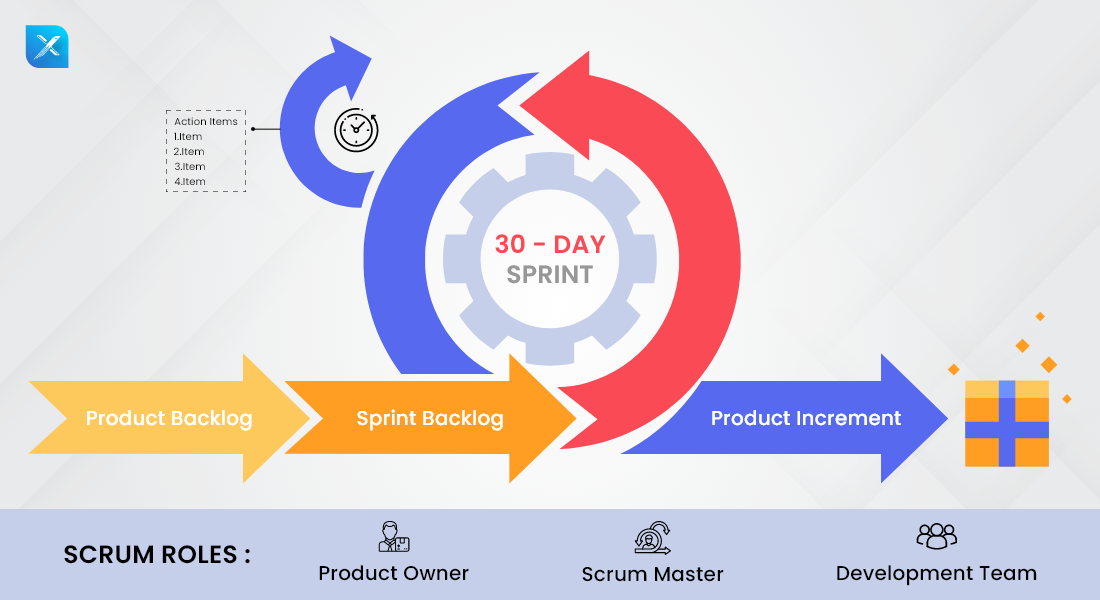AI Implementation in Business: 10...
July 14, 2025
By Dharmesh Patel June 27, 2022

You’ve certainly heard of a variety of project management approaches, such as Waterfall, Agile, Scrum, Kanban, etc, but which one is best for your project? Well, all the methodologies have their own pros which makes them different from each other.
This post will walk you through the Scrum project management approach to evaluate if it’s a good fit for your team or not. This blog will answer all your questions related to Scrum project management.
Scrum is a simple framework that assists individuals, groups, and organizations in creating value by finding adaptable solutions to challenging issues. With an original focus on software development, Scrum is a framework for creating, delivering, and maintaining products in a complex environment. It has also been applied to advanced technologies, sales, and marketing.
Scrum is an agile framework that is designed to offer value to the customer throughout the project’s development. It is adaptable, rapid, flexible, and effective as well when it comes to agile software development. Scrum’s main goal is to meet the needs of the customer by fostering a culture of open communication, shared ownership, and continuous improvement. The development process begins with a rough understanding of what needs to be produced and what elements should be taken into consideration while developing.
While other project management approaches emphasize achieving an entire product in a single operation, the agile methodology scrum focuses on delivering several iterations to stakeholders so they can get the maximum value in the shortest time possible.
( Scrum methodology adheres to Agile’s goals and principles, but adds extra definitions and requirements, particularly for specific software development techniques )
Agile is a method for a team to work more effectively and manage the project by dividing it into multiple stages. This help employees for maintaining a consistent collaboration with stakeholders and make continuous improvements with time at each level. Agile software development can be followed with any of the technology that you choose for your project. For example, you can approach a Python development company to practice the agile methodology with the project. The below-mentioned four ideals are applied differently in each Agile approach, but they all rely on them to drive the development and delivery of high-quality, working software.
To know more about this you can check out our blog for things to know about Agile Software Development in Python.

The principles are the guiding principles of agile methodologies. The increases its value among the clients. They define a work environment where change is welcomed and the client is the center of attention. They also demonstrate the Agile Manifesto’s aim, which is to bring development in line with business demands.
Take a look at the Agile Manifesto’s principles.
Scrum Artifacts are intended to ensure that critical information is transparent during decision-making.
Backlog of Products (PB): A product backlog consists of all the features and specifications the product needs to meet customer needs. It is created by the product owner to prioritize certain features and functions. They are set as per the company expectations and requirements. It is the key area of responsibility of the product owner to find out what should be done and what should not.

Sprint Backlog (SB): A sprint backlog consists of items that the team has selected to work on during the sprint. Each Sprint’s duration is determined by the team. The sprint backlog is shown on the physical boards known as Scrum boards, which are responsible for making the development process accessible to everyone who works on the development process.
( Sprint only takes 2 -4 weeks to complete a cycle )
Increment: Each sprint is comprised of a set of tasks, use cases, user stories, product backlogs, and any resulting software that will be available to the user when the sprint is over.
Scrum is one of a component of the agile process. Agile is a big tent, but scrum is a big part of it. Consider Scrum to be a framework for implementing agile development as it can be a boon for your company. The chances of successful project delivery get increased by implementing agile development methodologies.
Scrum gives a way to apply agile to your project because agile does not have a set of processes to follow. Scrum has many advantages over extreme programming and feature-driven development, but its simplicity is what makes it so appealing for agile development.
Scrum can also be used as a springboard toward other agile methodologies. It’s also not just a software framework; it may help with a wide range of undertakings.
( Agile is a set of beliefs and principles that describe how a group interacts and works on a daily basis. )
To complete any project with an effective methodology it is necessary to set a few key roles and assigned different responsibilities to them In Scrum methodology, it is the product owner, Scrum Master and Scrum development team exist who handles the project and ensure its successful delivery.

Product owner
While working through sprints and prioritizing the backlog, the product owner should act as a stand-in for the client and keep the stakeholders’ best interests in mind.
The product owner’s job is to lead the team and foster open communication among all employees. They even communicate the project’s vision to the team, as well as validate their benefits. Other than this Product owners are organized and always available to provide clarification during the project life cycle.
Scrum master
It is the person in charge of leading the team and ensuring that they follow the methodology’s rules and processes properly. The scrum master is in charge of reducing project barriers and collaborating with the Product Owner so that high returns can be achieved. It is all to maximize the ROI. The Scrum Master is responsible for maintaining Scrum up to date, as well as providing mentoring, and training to teams if needed.
Development team
The remaining Scrum participants are members of the development team who are responsible for completing the product deliveries on time. On the development team, programmers, designers, authors, and platform-testers are all involved in the creation of the product.
The development team in Scrum is self-directed, and each member collaborates to accomplish each sprint. The development team must agree on the optimal method for completing the deliverables. then only the success can be achieved.
The product owner and Scrum master will convene a series of planning meetings to determine the project’s features once roles have been established and staffed.
( Regular communication is a key feature of the Scrum process that sets it apart from others )
Have you ever wondered why Scrum is famous as compared to others? Well, you must think about it.
Over the years Scrum has gained significant popularity in different industries. Today, whenever someone thinks to adopt Agile methodology, Scrum is the first word that comes to their mind.
It helps companies to achieve their business goals and encourages creativity and innovation. Some may argue that these benefits are available in other Agile frameworks. Despite the popularity of other Agile frameworks such as XP and Kanban, Scrum remains the most popular agile framework.
The following are some of the reasons for this:


Consider these common Scrum phases of effective project management. You can hire a Python development company like us if you want to manage your Scrum project effectively.
In the initial phase, you have to define the project vision and mission with the objective of yours which you are going to accomplish through the project.
You establish plans for a sprint during this phase and find ways for a team to collaborate more successfully. When your team completes each sprint, you can merge them later to complete all of the project backlog’s required pieces.
The execution phase is when you and your team put the sprint into action according to the plan. At this point, you manage the backlog by removing items as staff complete them and assigning items as they become available.
Schedule or review the meeting with your team at the end of each project so that you can discuss the sprint properly. Through this, you can observe what is going well and what are areas of improvement in the completed sprint.
The final step is the releasing phase where the final delivery gets done.
Here final products get offered to the clients. Consider holding a project retrospective meeting with your team after the product has been released to examine the performance of each individual sprint and to discuss the project’s overall performance. Identifying places where things go well and areas, where things go wrong, will help you figure out what to aim for and what to avoid in future Scrums so you can get the most out of your next project.
In comparison to other development techniques, the Agile methodology Scrum offers various benefits that can bring ease to the project management process. In the software industry, it is currently the most widely used and accepted framework. Let’s have a look at some of the major advantages of Scrum.
Adaptability: Agile Scrum project management require frequent check-ins and updates so that changes don’t go unnoticed for weeks. By following this approach you can analyze the challenges and make on-time changes at an early stage. Through this, your project will face a steady and on-time development through time and you can save your project from facing significant changes.
Easily Scalable: Scrum processes are iterative, and they’re performed within specific time frames, making it easy for a team of developers to focus on specific features during each period.
This not only results in superior deliverables tailored to the demands of the user but also allows teams to scale modules. For example, it helps in scaling functionality, scope, design, and characteristics in a systematic, and straightforward manner.
Compliance with expectations: Here client shows its expectations and requirements related to the project and conveys each and every detail of the project. Then a team of experienced professionals estimates the agile software development project and set their priorities. It is the responsibility of the product owner to check whether the set priorities and standards are matched or not. It is necessary as they have to give feedback to the team.
Time to Market: Because the scrum approach takes a short time to start, it leads to faster delivery and consequently an earlier time to market. Increasing development also means delivering solutions more quickly, without necessarily completing the project.
Provides Motivation On Several Levels: Deadlines and expectations are set forth in the scrum technique. As a result, the employees always work hard as a team to reach their goals. They are also driven by the benefits they receive for finishing a task on time and correctly. As a result of the technique, the team has a comprehensive collection of knowledge that they may show a client.
Transparency is created: The scrum approach ensures that employees complete their tasks on time and that the organization and its clients are both transparent. Every member is kept informed of any small changes to the project. Transparency breeds trust, which leads to greater business for the company.
Visibility: Stakeholders have the choice of viewing a project’s progress at any time during its life cycle, not just at predetermined periods near the start and the finish. It helps stakeholders in determining the project success ratio and increases their confidence in the successful delivery of the project.
With the stakeholders, the entire team feels more involved, which allows everyone to collaborate and track the project’s progress from beginning to end.
While scrum can benefit a wide range of companies and projects, the following are some beneficiaries who can get the maximum benefit from scrum methodology.
Most complicated projects: Scrum technique is suitable for projects that require teams to complete a backlog. Scrum breaks divide each process into manageable portions, making even the most difficult projects manageable. Most companies who have complicated projects go with Python development as it gets easy to handle the complications with Python.
Companies That Believe In Deriving Results: Scrum is also advantageous to companies that focus on deriving results instead of focusing on only documented progress of the process. This is because, rather than a thorough, strict method, scrum focuses on efficiency and innovation to achieve the set target.
Organizations That Cater To Clients: Scrum can assist companies that build products based on the tastes and specifications of their customers. Scrum is changeable, which is important when responding to client needs. Scrum is best at fulfilling these kinds of needs.
Apart from this, various industries are there which are benefiting from an Agile Scrum approach such as –
When it comes to finishing projects successfully and efficiently, Scrum project management is a godsend for businesses. The Scrum approach is crucial to completing projects successfully. It is advised that you give the Scrum technique a try now that you have all the necessary information. This strategy is applicable to all programming languages. You can follow this approach to Python development projects. Contact us and we’ll assist you in transforming your present procedure into a superior one.

Written by Dharmesh Patel

July 14, 2025
